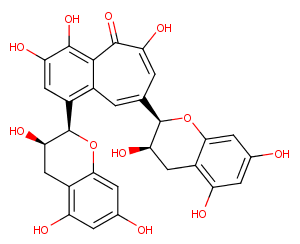产品信息
Theaflavin is a polyphenolic flavonoid that has been found in black tea and has diverse biological activities, including antioxidant, anticancer, anti-inflammatory, and antiviral properties
|
CAS号
|
4670-05-7 |
| 分子式 |
C29H24O12 |
| 主要靶点 |
Endogenous Metabolite|Influenza Virus |
| 主要通路 |
微生物学|代谢 |
| 分子量 |
564.49 |
| 纯度 |
95.77%, 此纯度可做参考,具体纯度与批次有关系,可咨询客服 |
| 储存条件 |
Powder: -20°C for 3 years | In solvent: -80°C for 1 year |
| 别名 |
|
体内活性
In the pretreated ICH rats TF significantly alleviated the behavioral defects, protected BBB integrity, and decreased the formation of cerebral edema and the levels of ROS as well as inflammatory cytokines (including interleukin-1 beta [IL-1β], IL-18, tumor nectosis factor-alpha, interferon-γ, transforming growth factor beta, and (C-X-C motif) ligand 1 [CXCL1]).?Nissl staining and TUNEL displayed TF could protect against the neuron loss and apoptosis via inhibiting the activation of nuclear transcription factor kappa-β-p65 (NF-κβ-p65), caspase-1, and IL-1β[2].
体外活性
Theaflavin inhibits the growth of OVCAR-3 and A2780/CP70 human ovarian cancer cell lines, but not the ovarian epithelial cell line IOSE 364 (IC50s = 11.9, 38.5, and >40 μM, respectively)[1].
溶解度
DMSO:5.65 mg/mL (10 mM),Sonification is recommended.
细胞实验
Cell proliferation assay, Hoechst 33342 staining assay, Caspase-Glo Assay, western blot, human umbilical vein endothelial cell tube formation assay and vascular endothelial growth factor (VEGF) enzyme-linked immunosorbent assay were performed[1].
动物实验
ICH rat models were induced with type VII collagenase and pretreated with TF by gavage in different doses (25 mg/kg-100 mg/kg).?Twenty-four hours after ICH attack, evaluated the rats' behavioral performance, the blood-brain barrier (BBB) integrity, and the formation of cerebral edema.?The levels of reactive oxygen species (ROS) and inflammatory cytokines were examined by 2',7'-dichlorofluorescin diacetate and enzyme-linked immunosorbent assay.?Nissl staining and transferase dUTP nick end labeling (TUNEL) were aimed to detect the neuron loss and apoptosis, the mechanism of which was explored by Western blot[2].

